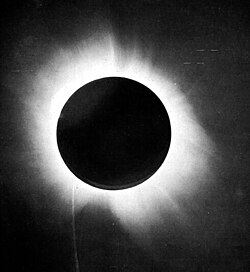| Annular eclipse | |
| Gamma | −0.9157 |
|---|---|
| Magnitude | 0.9791 |
| Maximum eclipse | |
| Duration | 77 s (1 min 17 s) |
| Coordinates | 88°00′S124°48′E / 88°S 124.8°E |
| Max. width of band | 189 km (117 mi) |
| Times (UTC) | |
| Greatest eclipse | 9:27:20 |
| References | |
| Saros | 121 (55 of 71) |
| Catalog # (SE5000) | 9323 |
An annular solar eclipse occurred at the Moon's ascending node of orbit on Friday, December 14, 1917, [1] with a magnitude of 0.9791. A solar eclipse occurs when the Moon passes between Earth and the Sun, thereby totally or partly obscuring the image of the Sun for a viewer on Earth. An annular solar eclipse occurs when the Moon's apparent diameter is smaller than the Sun's, blocking most of the Sun's light and causing the Sun to look like an annulus (ring). An annular eclipse appears as a partial eclipse over a region of the Earth thousands of kilometres wide. Occurring 4.6 days before apogee (on December 18, 1917, at 22:10 UTC), the Moon's apparent diameter was smaller. [2]
Contents
- Eclipse details
- Eclipse season
- Related eclipses
- Eclipses in 1917
- Metonic
- Tzolkinex
- Half-Saros
- Tritos
- Solar Saros 121
- Inex
- Triad
- Solar eclipses of 1916–1920
- Saros 121
- Metonic series
- Tritos series
- Inex series
- Notes
- References
This was the last of four solar eclipses in 1917, with the others occurring on January 23, June 19 and July 19.
The path of annularity crossed Antarctica. A partial eclipse was visible for parts of Antarctica, southern South America, and Australia. This annular eclipse is notable in that the path of annularity passed over the South Pole.








































































































